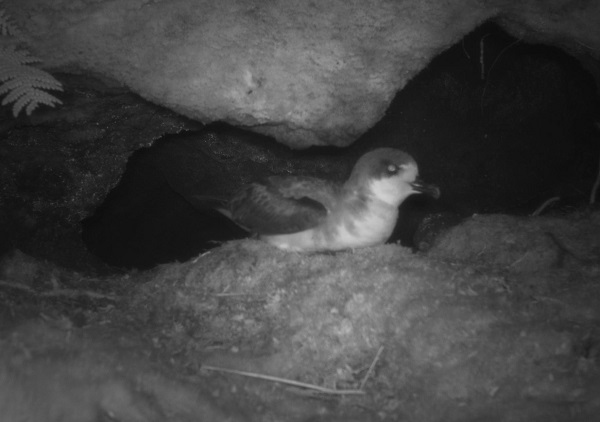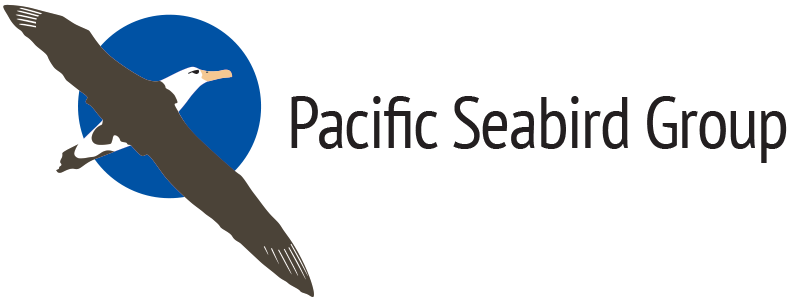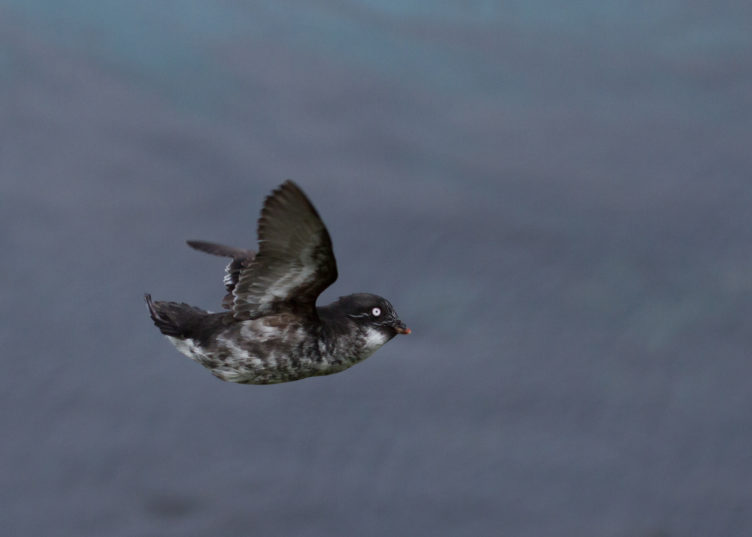Raine et al. (2024)
Author Information
André F Raine, Jennifer Rothe, Marc Travers: Archipelago Research and Conservation
Work Conducted by Archipelago Research and Conservation in 2023
The team from Archipelago Research and Conservation (ARC) continued multiple long-running conservation and research programs on the island of Kauaʻi, focused on the three endangered seabirds breeding on the island: ‘Aʻo (Newell’s Shearwater; Puffinus newelli), ‘Uaʻu (Hawaiian Petrel; Pterodroma sandwichensis) and ʻAkēʻakē (Band-rumped Storm-petrel; Oceanodroma castro). Seabird monitoring continued at Upper Limahuli Preserve, five sites in Hono O Nā Pali Natural Area Reserve, and Honopū to assess the effectiveness of management actions, primarily control of introduced predators. This work is carried out as part of the Kauaʻi Island Utility Co-operative (KIUC) Habitat Conservation Plan process and has been occurring annually at many of these colonies for over a decade. The results at the end of the 2023 breeding season continued to show increased reproductive success rates and call rates across all sites, highlighting the positive effects of seabird management in these areas. Geolocators were also deployed for the second year in a row on adult ‘Aʻo and ‘Uaʻu to obtain data on the wintering grounds of both species.

In addition to the above management sites, ARC also continued to monitor two social attraction project sites, Honopū and Pōhākea. Both sites are now in their second year of broadcasting seabird calls from within the protection of predator-proof fences. At Pōhākea, two natural burrows were recorded being excavated by ‘Aʻo and nine artificial burrows showed signs of ‘Aʻo activity, while at Honopū there was one artificial nest box being actively used by an ‘Aʻo and a further nine artificial burrows with signs of ‘Aʻo activity. Lastly, at Honopū, an ʻAkēʻakē was recorded landing in front of an artificial burrow – the first record of this species in the enclosure.
Away from existing management sites, ARC teams also undertook surveys for endangered seabirds at multiple new sites on Kaua‘i. Surveys included nocturnal surveys using night vision and thermal cameras as well as the deployment of acoustic sensors and cameras. Several new colonies of ‘Aʻo and ‘Uaʻu were identified, and locations of burrows and hotspots of activity can be used to help guide future management actions by landowners of these areas.

Song Meters were deployed by ARC at 24 sites along the ridges and slot canyons of the Nā Pali Coast. Call rates for ‘Aʻo, ʻAkēʻakē and Barn Owl (Tyto alba; an introduced avian predator of seabirds in Hawaii) were analysed from these units to assess the effectiveness of Barn Owl control in the area. Several of these sites now have over a decade of acoustic data. ARC also continued work at the Kōkeʻe Air Force Station (the site of a major fallout event of adult ‘Aʻo and ‘Uaʻu in 2015), monitoring the new lights at the site to assess potential attraction effects by using acoustic sensors, cameras, and nocturnal surveys. In 2023, a grounded ‘Aʻo was recorded at the site on a monitoring camera – the first since 2020 and one of only two recorded since the AFS changed its lighting protocols at the beginning of 2016. However, light attraction continues to be minimal at the site due to the site-level changes initiated at the station.
Also along the Nā Pali Coast, ARC and project partners initiated a seabird restoration project at Nu‘alolo Kai. This project aims to restore seabird populations (including ‘Aʻo, ʻAkēʻakē, Bulwer’s Petrel (Bulweria bulwerii), and Wedge-tailed Shearwater (Ardenna pacifica)) through social attraction in tandem with ongoing cultural restoration work at the site. As well as the important conservation element of this project, the restoration work also includes an outreach component and seeks to highlight the critical importance of seabirds to the Polynesian people originally living in the valley. The project partners are the Nā Pali ‘Ohana, State Parks, American Bird Conservancy, Hallux Ecosystem and Restoration LLC, and ARC.

As part of ARC’s Infrastructure Monitoring and Minimization Project (IMMP), work continued through KIUC’s HCP to investigate seabird take through powerline collisions on Kauaʻi. Powerline collisions have been identified as one of the largest conservation threats facing endangered seabirds on Kaua‘i. Using acoustic monitoring of power line collisions, direct observations of seabird collisions, and dead birds under wires, annual collision estimates were again created for the island. Based on these data, the utility company KIUC has undertaken large scale minimization actions across the majority of the Kaua‘i power grid, using bird diverters (both reflector and LED Diverters), removing the static wire (the top line), and lowering and consolidating lines into horizontal configurations. ARC continued to monitor the effectiveness of these minimization actions, which are significantly reducing powerline collisions.
Away from Kaua‘i, ARC also continued undertaking seabird monitoring work in American Samoa in partnership with the Department of Marine & Wildlife Resources (DMWR), National Park of American Samoa and USFWS Pacific Region (Endangered Species Recovery, Coastal, Migratory Birds, and Inventory and Monitoring programs). Despite its large seabird colonies, little contemporary work has been undertaken in American Samoa. ARC deployed acoustic sensors and monitoring cameras at multiple locations on the island of Tutuila and successfully located multiple colonies of Tahiti Petrel (Pseudobulweria rostrata; including the first active burrows found for this species on Tutuila in almost 40 years) and Tropical Shearwater (Puffinus bailloni; not previously confirmed breeding on the island). Two at-sea surveys were also conducted around the entirety of Tutuila, with locational data recorded for all seabirds sighted. Highlights included large breeding colonies of Red-footed Boobies (Sula sula), Brown Booby (Sula leucogaster) and Brown Noddies (Anous stolidus), as well as the first confirmed breeding record of Masked Booby (Sula dactylatra) on Tutuila.






